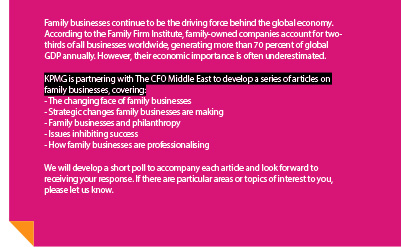KPMG Lower Gulf’s partner for advisory services Tasneem Lakdawalla gives her take on how the GCC’s family businesses can weather tough transitions to ensure their longevity.
SMEs have been a driving force for many economies. Within the GCC, they account for over 70 percent of GDP and are an increasingly important economic force. SMEs are typically family-owned and managed, and the GCC is home to many that have blossomed into large conglomerates. Family-owned businesses have often proved to be both resilient and successful, doing very well and outperforming non-family peers. Nevertheless, these businesses tend to operate within a ‘closed’ structure and often have a strong desire to retain control.
 In this article, the first in a series directed at family businesses, we look at a key issue that inhibits the growth of family businesses – funding. We suggest strategic priorities these businesses need to focus on to move to the next level. And we look at why some family businesses fail. Owners of family businesses tell us they want to know how to innovate, despite their limited financial capabilities to invest in innovation or transformation. They want to know how to increase turnover and improve profit margins despite mounting cost pressures. They want to be able to diversify product portfolios – or to understand how to sell goods and services in other geographies or markets.
In this article, the first in a series directed at family businesses, we look at a key issue that inhibits the growth of family businesses – funding. We suggest strategic priorities these businesses need to focus on to move to the next level. And we look at why some family businesses fail. Owners of family businesses tell us they want to know how to innovate, despite their limited financial capabilities to invest in innovation or transformation. They want to know how to increase turnover and improve profit margins despite mounting cost pressures. They want to be able to diversify product portfolios – or to understand how to sell goods and services in other geographies or markets.
Growth is possible.
There is no doubt that liquidity across the GCC is tighter now than it used to be, and that there are considerable business headwinds to deal with. But the private sector is healthy, adaptable and used to competition. At the same time, there is considerable assistance available for local companies. As well as banks, SMEs and GCC-owned family businesses have access to funds at reasonable lending rates from various government bodies, chambers of commerce, government-related entities and NGOs.
In addition, organisations like KPMG help family businesses by supporting their innovation plans and preparing and validating the business models which back them. Family businesses can then approach lending and other financial service institutions with viable business plans to help them get access to funds. Organisations like KPMG can help rationalise costs, analyse trends in past data to support predictive analysis towards growth and expansion, or look at the extension of markets to other geographies.
Growth and expansion have made family businesses think about – and be increasingly open to – new ways of financing. Very few businesses are entirely self-reliant on internal funding, and SMEs with operations in global markets are keen to leverage the different, possibly cheaper funding options available in new geographies. Funding options are no longer used to meet short or medium-term goals but are viewed as long term investment options. Traditional lenders are facing competition from other players like private equity houses, high net worth individuals and long term investors. New financing options may mean relinquishing controls but this comes with benefits like strategic alliances and tie ups and access to overseas markets and customers. The choice of investment partner is critical.
 Once funding is secure, and as companies grow, owners often look to professionalise their existing management teams. Organisations are increasingly looking outside their ‘closed’ teams to seek help from professionals to help run and manage their business. External professionals bring with them a variety of skills and benefits, including an outside-in view which simultaneously improves governance and processes, balances family concerns and business interests, and maintains family control. Involving external leaders helps decision makers take effective decisions without being prejudiced by sentiment. External decision makers may suggest that it is time for change at the top.
Once funding is secure, and as companies grow, owners often look to professionalise their existing management teams. Organisations are increasingly looking outside their ‘closed’ teams to seek help from professionals to help run and manage their business. External professionals bring with them a variety of skills and benefits, including an outside-in view which simultaneously improves governance and processes, balances family concerns and business interests, and maintains family control. Involving external leaders helps decision makers take effective decisions without being prejudiced by sentiment. External decision makers may suggest that it is time for change at the top.
Today’s business owners are increasingly aware of succession planning issues. Rather than waiting until retirement or old age, the next generation is being groomed earlier to be trained and so management, ownership and governance experience can be passed on. The next generation tends to be better equipped to deal with changing business and – more importantly – technology trends that are driving operations today. From proficiency in understanding international markets and digital trends to working across multiple jurisdictions, these organisations gain from millennials’ experiences.
An alternative is to sell the business. Handing over a family business to the next generation is make-or-break time for most family-run businesses, and statistics reveal the disparity between the optimistic intentions of business owners and the massive failure of their companies to survive through the generations. The reality is alarming: only 30 percent of family businesses make it to the second generation, 12 percent make it to the third, and only 3 percent make it further than that. Without a good plan in place, each time the business passes into the hands of the next generation, it could face failure, no matter how well it was doing previously.
And SMEs do fail, with one or a combination of three key factors – increased competition, the war for talent, and declining profitability – usually to blame. Larger enterprises tend to cope better with increased competition than smaller enterprises. They tend to be better able to weather pressure, diversify or penetrate new markets. Failure is a necessary part of a market economy – and the consequences can be serious. Across the GCC, it is heartening to see different stakeholders coming together to support businesses when they find themselves overstretched.
SMEs are the backbone of the GCC economy and, despite numerous challenges, are responsible for generating jobs and improving financial stability. The future of SMEs is dependent on a range of factors, including their ability to attract and retain talent and to hand over successful businesses. There is no doubt that, despite the challenges, these businesses are here to stay and will be the rising stars of the GCC’s future economy.













